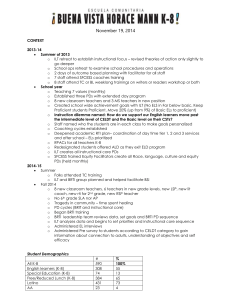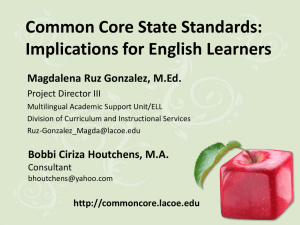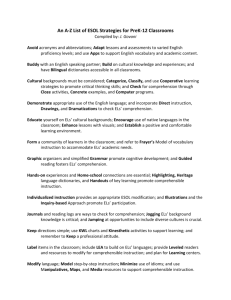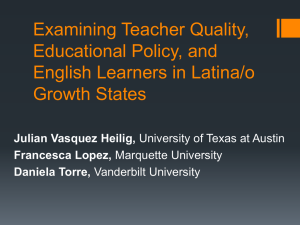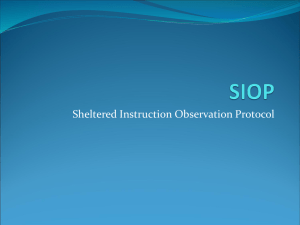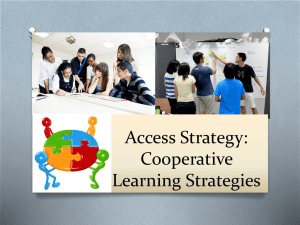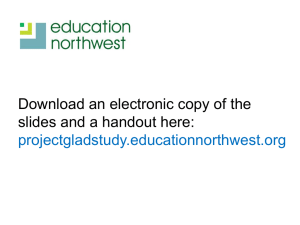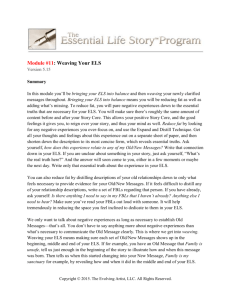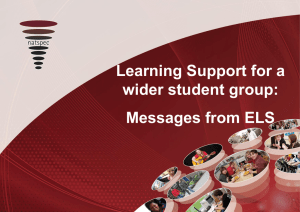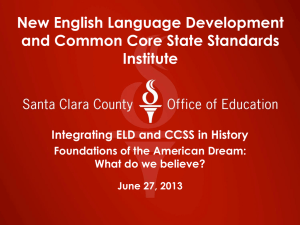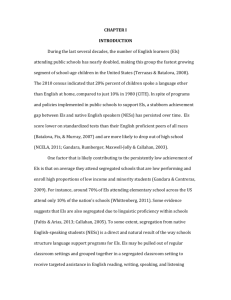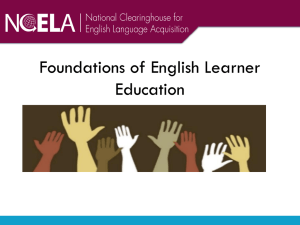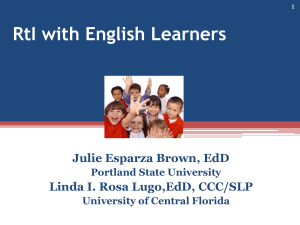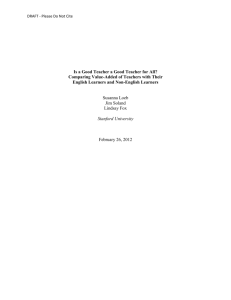Essential Elements for EL in Special Education and Developing IEP
advertisement
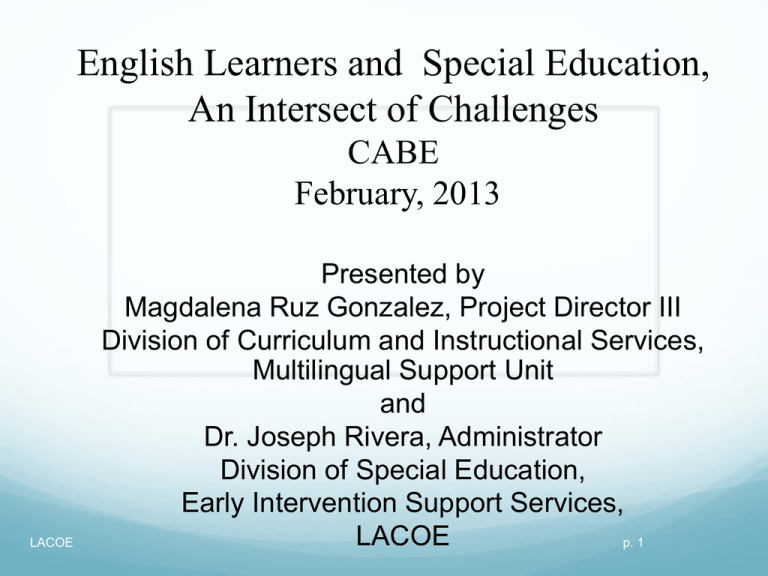
English Learners and Special Education, An Intersect of Challenges CABE February, 2013 LACOE Presented by Magdalena Ruz Gonzalez, Project Director III Division of Curriculum and Instructional Services, Multilingual Support Unit and Dr. Joseph Rivera, Administrator Division of Special Education, Early Intervention Support Services, LACOE p. 1 SESSION OUTCOMES To understand the how culturally and linguistically appropriate RtI2 can improve outcomes for ELs To understand the linguistic and cultural bias inherent in standardized assessments To learn legislation and litigation that protects ELs in Special Education settings To identify appropriate instruction and IEPs for this population DATA The drop out rate is 15-20% higher for EL than another subgroup. This lack of academic success is also the cause for referrals to special education. Is your district overrepresented with ELs placed in special education? Legislation Governing ELs Civil Rights Act (1964) (1970) Requirements: avoid labeling students mentally retarded based on criteria that reflects their English proficiency. IDEA (1975) (1997) ELs are not eligible for services if their learning problems are primarily the result of environmental, cultural or economic disadvantage. Legislation Governing ELs IDEA (1975) (1997) Evaluation and placement procedure must be conducted in the native language, unless it is CLEARLY not feasible to do so. (EC 56320, EC 56001) Assessment results must be considered by individuals knowledgeable about the child, assessment, and placement alternatives. The multidisciplinary team must consider the language needs of ELs when developing, reviewing or revising the IEP. Litigation Diana vs. CA State Bd. Of Ed (1970). One cannot identify a child as mentally retarded based on IQ tests administered in English. The child must be assessed in their first language. Larry P. vs. Riles. One cannot use IQ tests that do not take into account the culture and experiences of children. Thus, test must be valid for use with the specific populations. RESEARCH FINDINGS ELs are typically overrepresented or underrepresented in Special Education across the country. ELs in special education with learning disabilities demonstrate lower verbal and full scale IQ scores AFTER placement in Special Education. ELs are not receiving the type of instruction they need in regular education settings. ELs are not receiving the type of instruction they need in special education settings. Overrepresentation or Underrepresentation? Cross Student Group Comparison- # of all ELs placed in special education divided by the total # of ALL ELs in the LEA 197 placed = 19.7% 1,000 Total ELs in LEA # of non-ELs in special education 2,200 placed = 11% 20,000 total Non-ELs in LEA ELs are overrepresented by 8.7% Overrepresentation or Underrepresentation? Within Group Comparison- % of total ELs compared with % of ELs in entire special education population ELs= 23% of total school Thus, 23% of special education population should be ELs Prevention of ELs “Qualifying” for Special Education A Culturally and Linguistically appropriate RtI2 Determine conditions that must be met for referral for assessment Provide non-biased assessment and interpretation of results Culturally and Linguistically Appropriate RtI2 Tier 1 through 3 reflect a thorough understanding of ELs proficiency levels and what students are capable of doing High quality instruction: content and ELD Data discussions linked to EL instruction Materials are available at multi-levels and in native language Culturally and Linguistically Appropriate RtI2 Problem solving (individualized) versus program driven Instruction before intervention Demonstrate that an EL advocate on SST has expertise to guide, interpret and facilitate discussions at SST, design intervention programs and monitor progress in a timely manner. Conditions for Referrals Interventions have been well documented with sufficient details and of sufficient duration and intensity. SST validates EL difficulties across content areas and locations. Interventions have been conducted in both languages by qualified trained individuals. Documentation of instruction clearly indicates learning problems in both languages. Conditions for Referrals The teacher used instructional strategies known to be effective for ELs. Neither clinical teaching nor interventions resolved learning difficulties. All general education alternatives have proven unsuccessful. Documentation of parental involvement. Essential Elements To Address Biased and Non-biased Assessments Use of Native Language Aides, Interpreters and Translators Parent Participation Teachers Cross-training Can We Provide Non-biased Assessments? There is no test that can rule out the learning disability versus the language development issue. Standardized tests are normed on the majority culture and language (Caesar & Kohler, 2007) Misinterpretations applied to data; discrepancy formula and medical model Pitfalls of Parallel and Translated Tests Norms, Baselines and Ceilings Issues of Traditional Assessments Linguistic Bias Cultural Bias Time Factor Equivalent English and other language versions Receptive and Expressive One-Word Picture Vocabulary Tests, Fourth Edition (EOWPVT-4, ROWPVT-4) An Example of Item Analysis Test for Auditory Comprehension Of Language- Carrow Kinder Student; 6-11 C.A. Results- English 4-8 A.E. By adding the credit of Spanish: Obtained a Bilingual score 6-5 A.E. Use of Native Language Necessary in intervention and testing An English Learner will need bilingual testingno matter what CELDT level Watch for dialectical, regional and educational levels A necessity for low incidence English Learners Aides, Interpreters and Translators Interpreters are “language on demand” Translators provide written translations Training in educational jargon, information, and coordination Preview and training before the actual meeting Checking for meaning with “back translating” Teachers and Paraprofessionals Cross Training Language Development ELD and SDAIE methodology Special Education instructional modifications specific to exceptionalities Testing modifications and adaptations Legal requirements Consultation model Do ELs have appropriate IEP Goals? √ ELD √ Content Area access through SDAIE English Language Development Goals and Language of Instruction -For individuals whose native language is other than English, linguistically appropriate goals, objectives, programs and services. -ELD and content areas reflect linguistic support for EL. ELD GOAL: Increase Communication Beginning Level Objective: By__ (date)__, when given comprehensible input, such as ______, the EL will respond to the correct picture/object by (pointing, taking, walking to, acting out) with ___% accuracy as measured by __(records, observations). Use of ELD/ELA standards or CELDT Blueprints are useful. ELA/Math or other Content Goal (SDAIE) Same as an English Only Student except define: 1) How the instruction will be modified or adapted linguistically; 2) How the instruction will be delivered by language proficiency level; 3) And what tasks are supported or instructed through primary language. CELDT or ALPI? CELDT: Diploma bound ELs Alternative: Testing out of grade span ALPI: Lower Cognitive Skills Twenty Years of use For severely handicapped students Parent Interview Used for initial and ongoing English proficiency- instead of CELDT Cannot be used for reclassification http://sped.ocde.us/assest/sped/download/ALPI_manual.pd f.pdf Reclassification of Special Education ELs: Suggested by CELDT Guidelines 1. Assessment of Language Proficiency using an Objective Assessment Instrument 2 Teacher Evaluation 3. Parental Opinion and Consultation 4. Student’s Score on an Assessment of Basic Skills such as CAPA CELDT Guidelines… “In accordance with with federal and state law, the local IEP may address the individual needs of each English learner with a disability using multiple criteria…” p. 21 CELDT 2012-2013 Guidelines Federal Guidelines as it relates to ELs in Special Education Assessments with pupils of limited English proficiency shall be administered in the child’s native language or mode of communication, unless clearly not feasible to do so (EC 56320, EC 56001) No single procedure is used as the sole criterion for determining an appropriate educational program for an individual child (EC 56320, EC 56001) What are your next steps ? Q&A REFERENCES Special Education Considerations for English Learners: Delivering a Continuum of Services, (2007) Hamayan, Marler, Sanchez-Lopez, and Damico. Caslon Publishing. English Learners with Special Education Needs, Alfredo Artilles and Alba Ortiz (2002) CAL. http://mas.lacoe.edu
